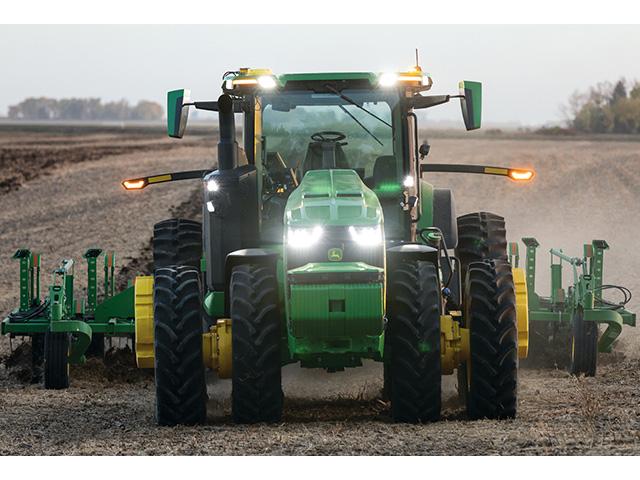Starlink, Deere Announce Broadband Deal
Deere Says Deal With Starlink Brings Vast New Opportunities to Ag
TThis article was originally posted at 8:24 a.m. CST on Tuesday, Jan. 16. It was last updated with additional information at 2:05 p.m. CST on Tuesday, Jan. 16.
**
Deere and Company announced on Tuesday it has entered into what it calls a "game-changer" agreement with SpaceX and its Starlink division to begin installing Starlink technology to its new and existing machines in the United States and Brazil this year.
"(Starlink offers) ubiquitous coverage, 100% of the time, anywhere, anytime," Michael Kool, senior product manager, connected fleet, at John Deere, told DTN/Progressive Farmer. "It is impactful. You can pull up your John Deere Operations Center and see where that machine is, pull machine diagnostics, send agronomic data, all in real-time, which ultimately allows our customers to make decisions in real-time based on real data."
This satellite communications (SATCOM) solution will initially be available through a limited release in the second half of 2024. Deere is not disclosing pricing at this time.
Starlink is not a replacement for the data management and communications systems currently offered by Deere. It is an additional after-market option for both new and used equipment installed at dealerships. Deere is currently working on a factory-installed option.
P[L1] D[0x0] M[300x250] OOP[F] ADUNIT[] T[]
To activate this SATCOM solution, John Deere dealers will install a ruggedized Starlink terminal on compatible machines, along with a 4G LTE JDLink modem to connect the machine to the John Deere Operations Center.
Starlink completes the communication puzzle in the field. Machinery operators will continue to use Wi-Fi where available and cellular connections where they exist, and when those two are not present, the Starlink SATCOM solution comes into play.
"We look at this to augment (cellular)," Kool said. "It is going to be a game-changer. Connectivity is a foundational building block for farmers. This is very impactful. I can't stress that enough."
The U.S. currently counts 46 million rural residents living across 72% of the nation's land mass, most living with difficult internet and cellular communication environments. Deere says 30% of U.S. cropland lacks suitable connectivity, as does most of rural America.
Deere began searching for a satellite communications solution 18 months ago when it hosted an industry event on Deere's test farm outside Bondurant, Iowa, with 40 of the world's largest vendors offering various solutions. Deere soon sent out a request for proposals, leading to Deere and Starlink signing this agreement.
"We are bringing satellite communications service to the farm at scale so farmers with cellular coverage challenges can maximize the value of connectivity to their operations," Jahmy Hindman, senior vice president and chief technology officer at John Deere, said in a Deere news release. "The SATCOM solution unlocks the John Deere tech stack so every farmer can fully utilize their current precision agriculture technology in addition to the new innovative solutions they will deploy in the future."
Starlink ought to find an enthusiastic place on the farm.
"For us," Marc Arnusch of Marc Arnusch Farms, Keenesburg, Colorado, told DTN/Progressive Farmer, "it would likely improve the information transfer process and give us better visibility of what's happening on our more remote farms -- whether it is in-cab or other open-platform technologies I'm using. Hopefully, it will improve cellphone signals through an internet link, too. Our cell coverage out here is awful."
Jeremy Jack, of Silent Shade Planting Company in Belzoni, Mississippi, told DTN/Progressive Farmer he looks forward to the new capabilities. "Our connectivity is fair at best," he said. "We make it work, but we do have certain areas where it is hard to receive a payload through cell signal." A payload, or software update to a controller on a piece of equipment, is sometimes a large package of data. Currently, Jack said, Deere brings a computer out to Silent Shade to load updates if they are too large to send directly to the machine.
"I think this will be great for producers to receive software updates faster," Jack said of the Deere-Starlink announcements. "As the complexity of the machines increases, larger software updates will be needed. This will also allow for video signals to be viewed remotely. This will allow for the industry to move forward around any roadblocks (that the lack of) connectivity has put up."
With 5,300 satellites, Starlink is the world's first and largest satellite constellation using a low Earth orbit to deliver broadband internet capable of supporting streaming, online gaming, video calls, and more. Starlink currently delivers high-speed, low-latency internet to 2.3 million users in 70 countries.
Dan Miller can be reached at dan.miller@dtn.com
Follow him on X @DMillerPF
(c) Copyright 2024 DTN, LLC. All rights reserved.




